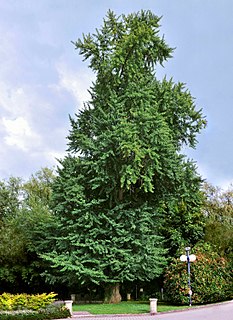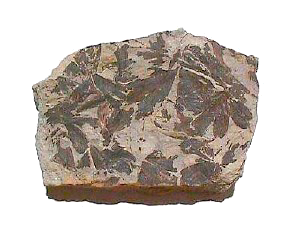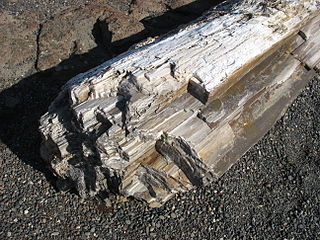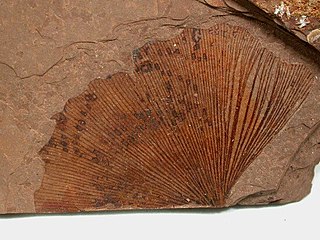
Ginkgo biloba, commonly known as ginkgo or gingko also known as the maidenhair tree, is a species of tree native to China. It is the last living species in the order Ginkgoales, which first appeared over 290 million years ago. Fossils very similar to the living species, belonging to the genus Ginkgo, extend back to the Middle Jurassic approximately 170 million years ago. The tree was cultivated early in human history and remains commonly planted.

Ginkgoales are a gymnosperm order containing only one extant species: Ginkgo biloba, the ginkgo tree. It is monotypic, within the class Ginkgoopsida, which itself is monotypic within the division Ginkgophyta. The order includes five families, of which only Ginkgoaceae remains extant.

The Ginkgoaceae is a family of gymnosperms which appeared during the Mesozoic Era, of which the only extant representative is Ginkgo biloba, which is for this reason sometimes regarded as a living fossil. Formerly, however, there were several other genera, and forests of ginkgo existed. Because leaves can take such diverse forms within a single species, these are a poor measure of diversity, although differing structures of wood point to the existence of diverse ginkgo forests in ancient times.

The gymnosperms are a group of seed-producing plants that includes conifers, cycads, Ginkgo, and gnetophytes, forming the clade Gymnospermae, the living members of which are also known as Acrogymnospermae. The term gymnosperm comes from the composite word in Greek: γυμνόσπερμος, literally meaning 'naked seeds'. The name is based on the unenclosed condition of their seeds. The non-encased condition of their seeds contrasts with the seeds and ovules of flowering plants (angiosperms), which are enclosed within an ovary. Gymnosperm seeds develop either on the surface of scales or leaves, which are often modified to form cones, or solitary as in yew, Torreya, Ginkgo. Gymnosperm lifecycles involve alternation of generations. They have a dominant diploid sporophyte phase and a reduced haploid gametophyte phase which is dependent on the sporophytic phase. The term "gymnosperm" is often used in paleobotany to refer to all non-angiosperm seed plants. In that case, to specify the modern monophyletic group of gymnosperms, the term Acrogymnospermae is sometimes used.

The ginkgo-toothed beaked whale is a poorly known species of whale even for a beaked whale, and was named for the unusual shape of its dual teeth. It is a fairly typical-looking species, but is notable for the males not having any scarring.

Engelbert Kaempfer was a German naturalist, physician, explorer and writer known for his tour of Russia, Persia, India, Southeast Asia, and Japan between 1683 and 1693.

Bilobalide is a biologically active terpenic trilactone present in Ginkgo biloba.

Ginkgo Petrified Forest State Park/Wanapum Recreational Area is a geologic preserve and public recreation area covering 7,124-acre (2,883 ha) on the western shoreline of the Columbia River's Wanapum Reservoir at Vantage, Washington. Petrified wood was discovered in the region in the early 1930s, which led to creation of the state park as a national historic preserve. Over 50 species are found petrified at the site, including ginkgo, sweetgum, redwood, Douglas fir, walnut, spruce, elm, maple, horse chestnut, cottonwood, magnolia, madrone, sassafras, yew, and witch hazel.

Bartram's Garden is a 50-acre public garden and National Historic Landmark in Southwest Philadelphia, Pennsylvania, situated on the banks of the Tidal Schuylkill River. It is a venue for art, an access to the tidal river and wetlands, an outdoor classroom, and a living laboratory. Founded in 1728 by botanist John Bartram (1699–1777), it is the oldest surviving botanical garden in North America. Bartram's Garden attempts to hold the colonial legacy of the land with a commitment to learn and share the whole truth about the plants of Southwest Philadelphia and the people who grow them.
In botany, a zoid or zoïd is a reproductive cell that possesses one or more flagella, and is capable of independent movement. Zoid can refer to either an asexually reproductive spore or a sexually reproductive gamete. In sexually reproductive gametes, zoids can be either male or female depending on the species. For example, some brown alga (Phaeophyceae) reproduce by producing multi-flagellated male and female gametes that recombine to form the diploid sporangia. Zoids are primarily found in some protists, diatoms, green alga, brown alga, non-vascular plants, and a few vascular plants. The most common classification group that produces zoids is the heterokonts or stramenopiles. These include green alga, brown alga, oomycetes, and some protists. The term is generally not used to describe motile, flagellated sperm found in animals. Zoid is also commonly confused for zooid which is a single organism that is part of a colonial animal.

"Gingo biloba" is a poem written by the German poet Johann Wolfgang von Goethe. The poem was published in his work West–östlicher Divan(West–Eastern Divan), first published in 1819. Goethe used "Gingo" instead of "Ginkgo" in the first version to avoid the hard sound of the letter "k".
GABA receptor antagonists are drugs that inhibit the action of GABA. In general these drugs produce stimulant and convulsant effects, and are mainly used for counteracting overdoses of sedative drugs.

Joseph "Krystel" Franz Freiherr von Jacquin or Baron Joseph von Jacquin was an Austrian scientist who studied medicine, chemistry, zoology and botany. The standard author abbreviation J.Jacq. is used to indicate this person as the author when citing a botanical name.

Ginkgo is a genus of non-flowering seed plants. The scientific name is also used as the English name. The order to which it belongs, Ginkgoales, first appeared in the Permian, 270 million years ago, and is now the only living genus within the order. The rate of evolution within the genus has been slow, and almost all its species had become extinct by the end of the Pliocene. The sole surviving species, Ginkgo biloba is only found in the wild in China, but is cultivated around the world. The relationships between ginkgos and other groups of plants are not fully resolved.

A spermatophyte, also known as phanerogam or phaenogam, is any plant that produces seeds, hence the alternative name seed plant. Spermatophytes are a subset of the embryophytes or land plants.

Ginkgotoxin (4'-O-methylpyridoxine) is a neurotoxin naturally occurring in Ginkgo biloba. It is an antivitamin structurally related to vitamin B6 (pyridoxine). It has the capacity to induce epileptic seizures.

Ginkgo yimaensis is an extinct ginkgo species in the family Ginkgoaceae. It is a gymnosperm, first described by Zhou and Zhang.

Ginkgo adiantoides is an extinct ginkgo species in the family Ginkgoaceae from the Late Cretaceous to the Miocene.
Deraniyagala's beaked whale is a species of mesoplodont whale.

Baiera is a genus of prehistoric gymnosperms in the order Ginkgoales. It is one of the oldest fossil foliage types of Ginkgoales, and is related to the genera Ginkgo and Ginkgoites. Fossils of Baiera are found worldwide, and have been known from the Permian to the Cretaceous.
















